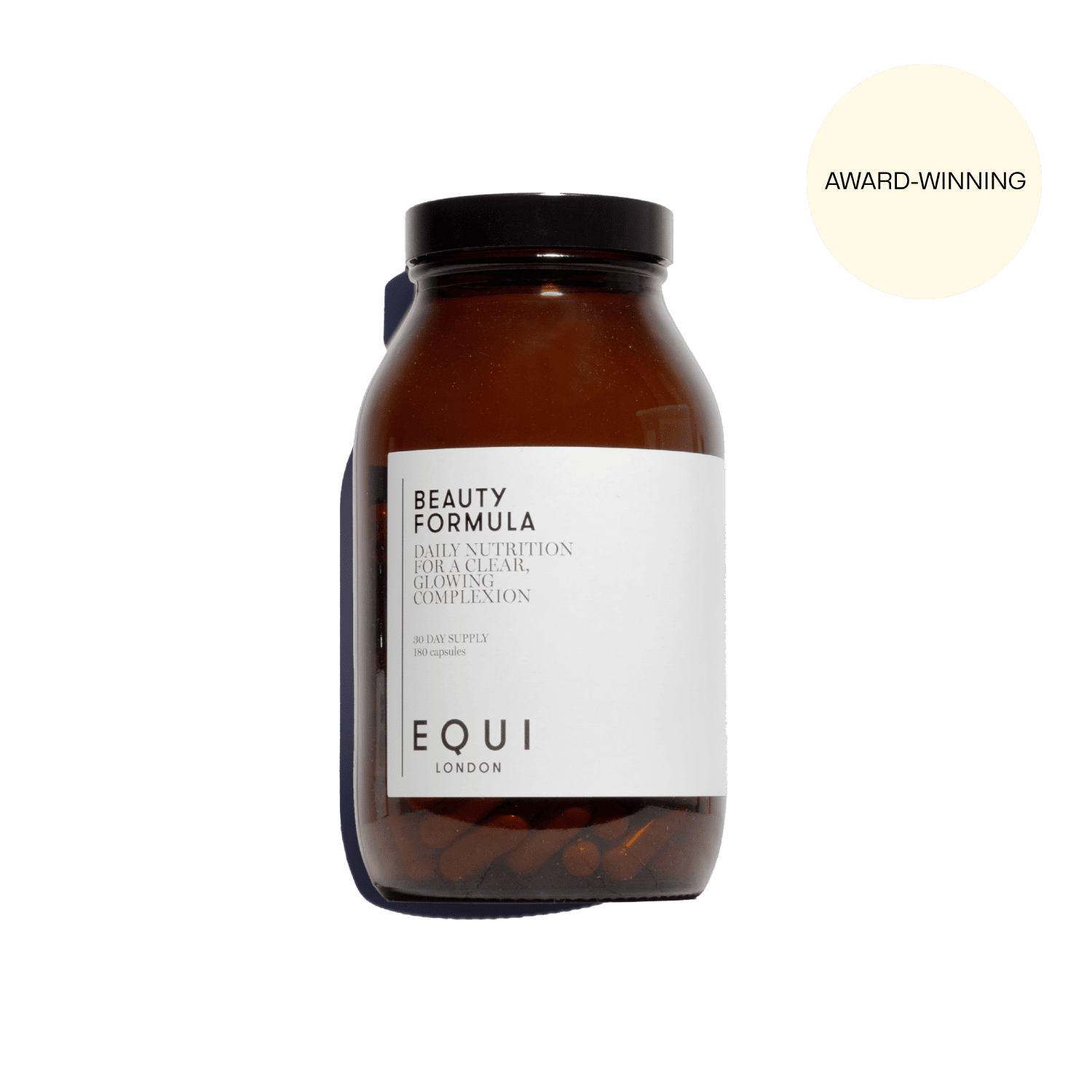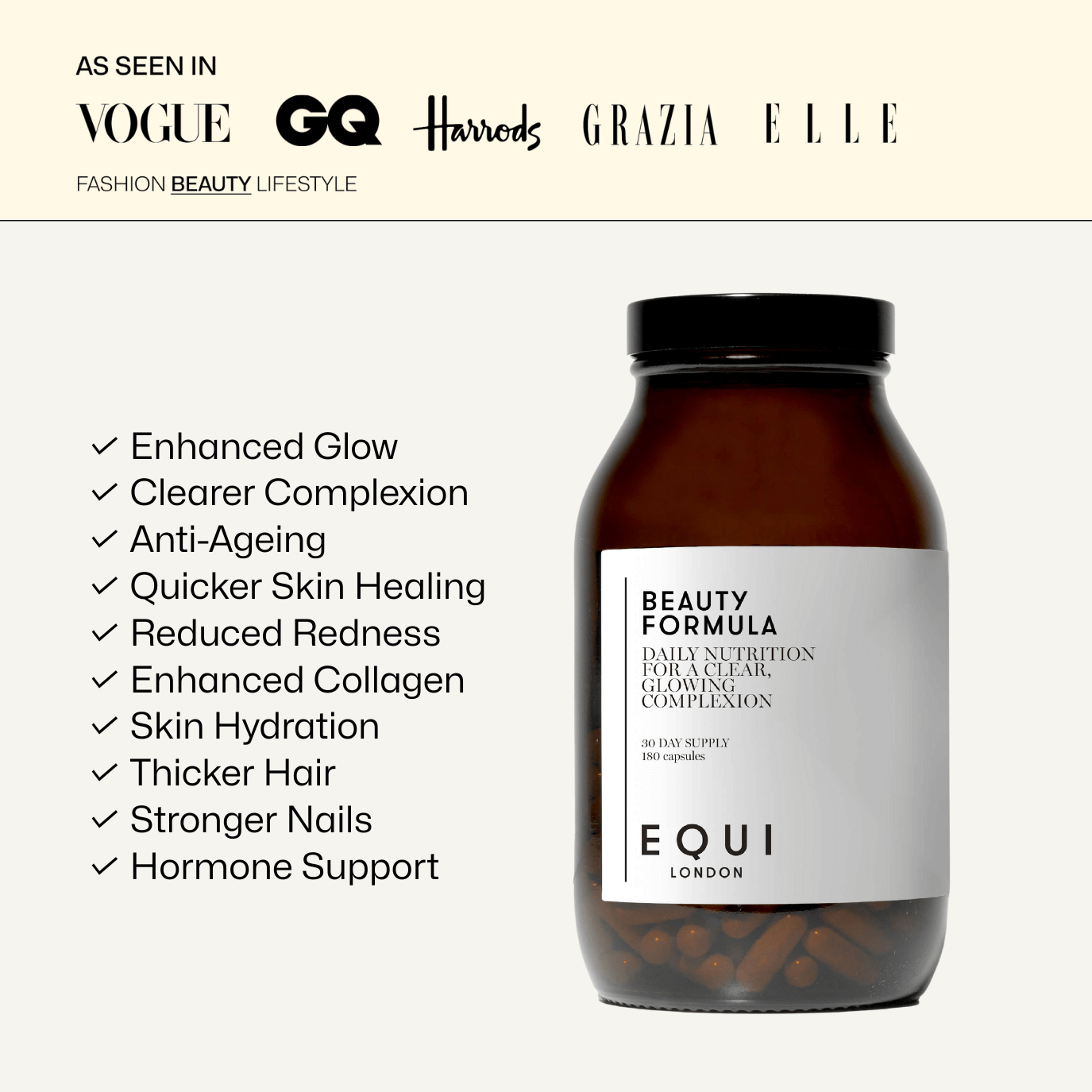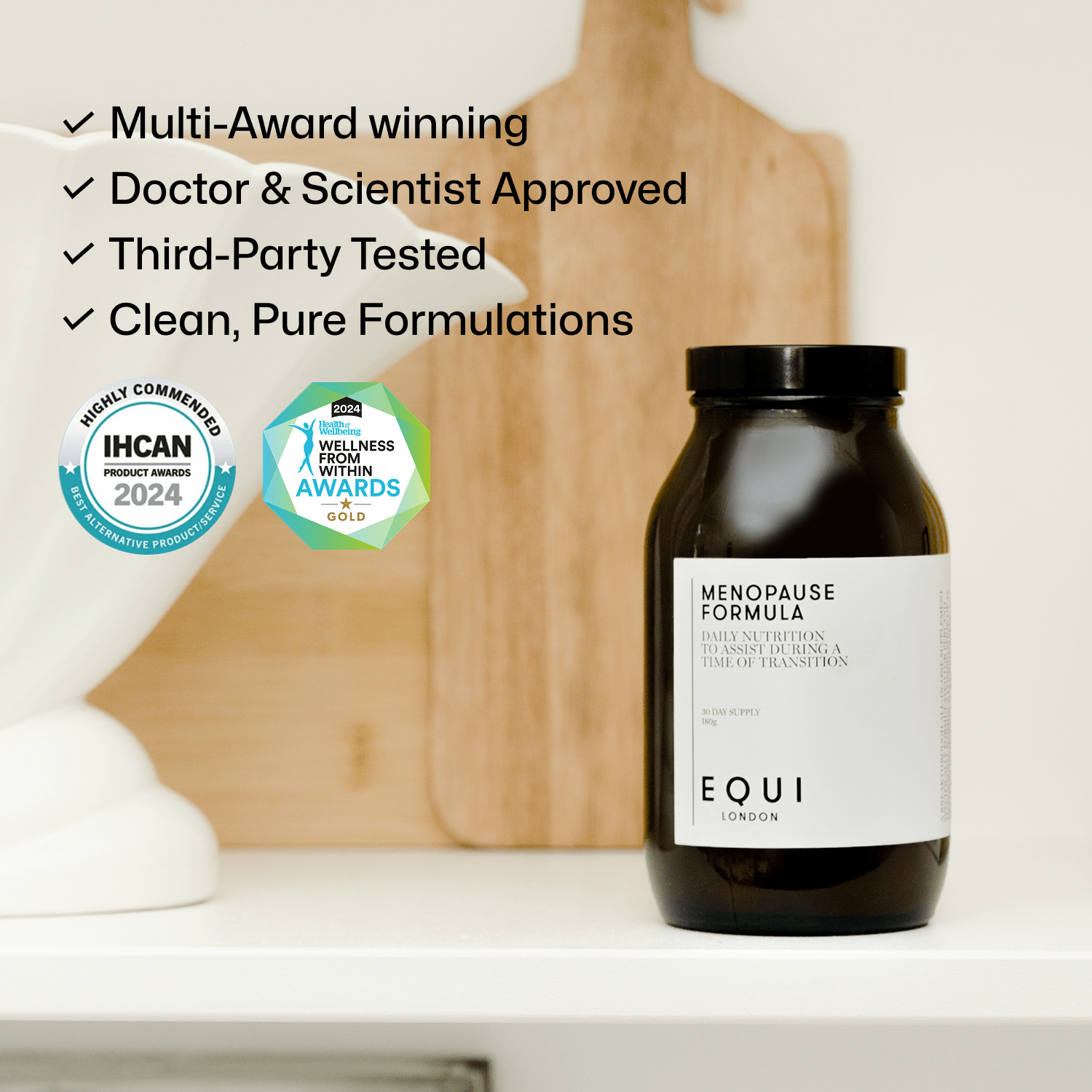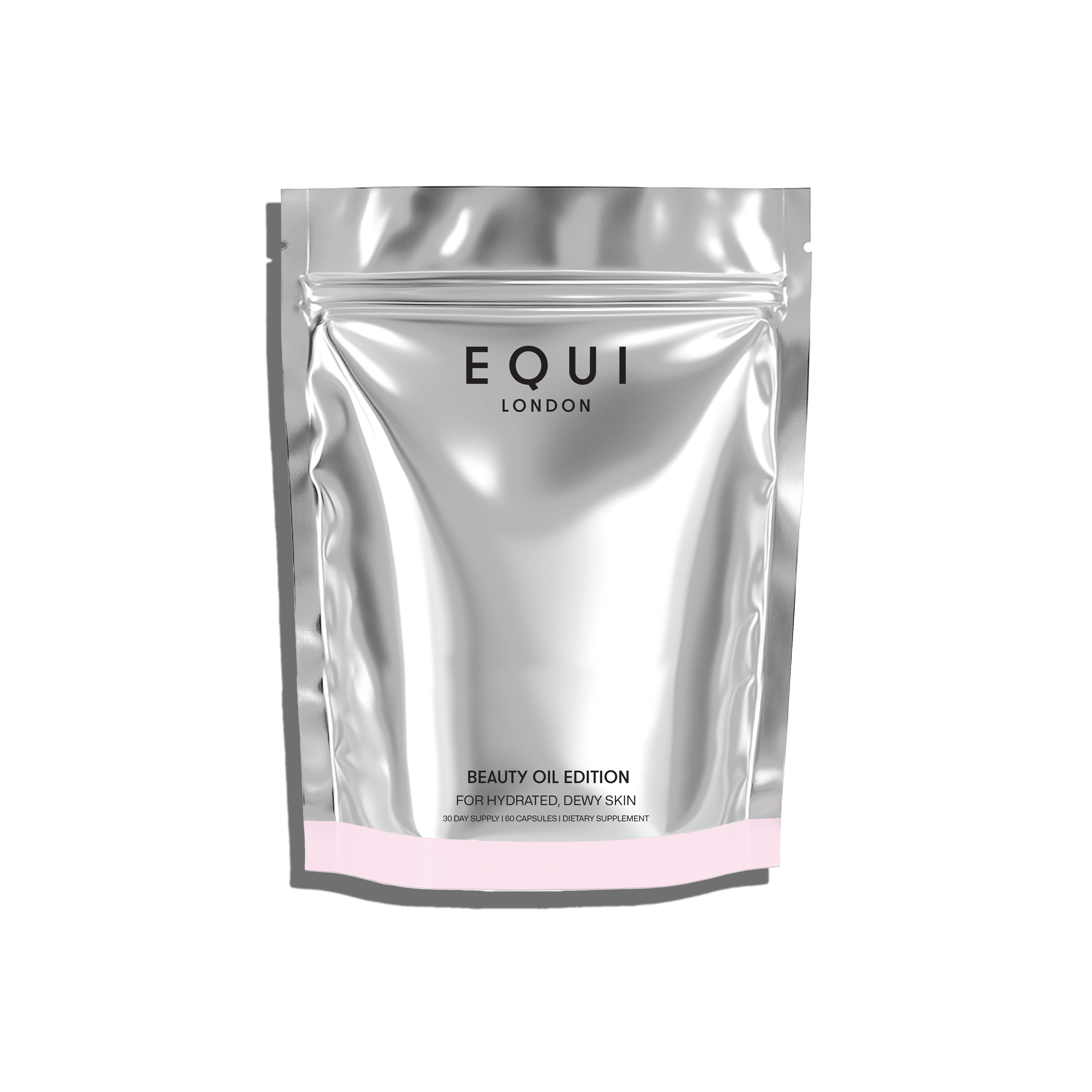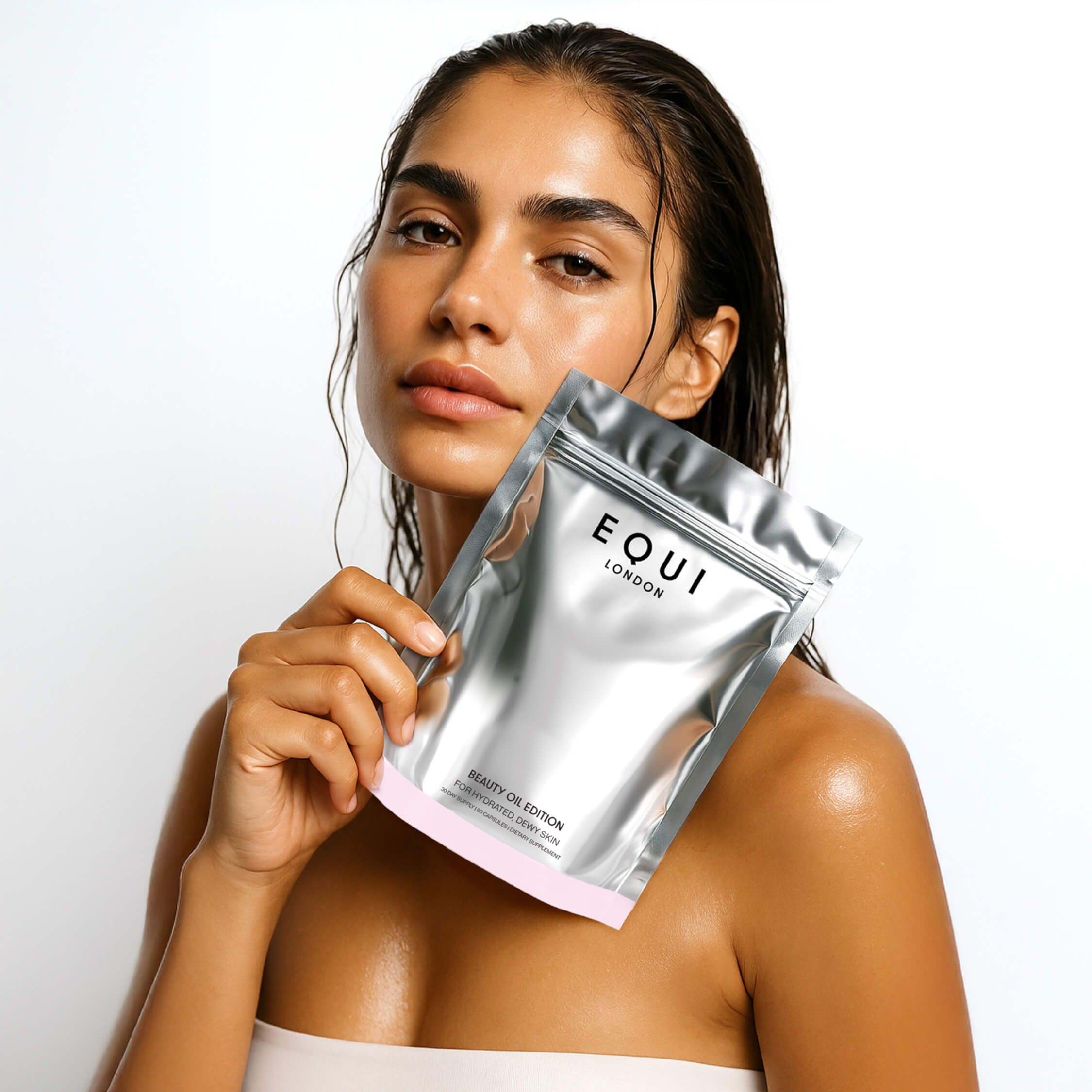
We all know that beauty isn’t just skin deep. The interconnection between our inner health and outer glow is better understood than ever before. Amidst the plethora of beauty products gracing our shelves, Beauty Formula goes beyond the surface, targeting the very foundation of our beauty: our inner health. Our award-winning Formula provides total body support from hormones to digestion, addressing the underlying causes of problem skin, hair, and nails, whilst supplementing your body with everything it needs to glow. With its blend of 48 of the most effective nutritional compounds not only proven to combat skin concerns, support collagen and hydration levels, it harmoniously enhances and strengthens our nails too. Beauty Formula is not your typical external application. Instead, it's a meticulously curated blend designed to nourish your body from the inside out.
When we think ‘beauty’, our minds often gravitate towards our skin — our largest organ which often takes the brunt of our daily stresses. But beauty, extends beyond this and is represented by the condition of our hair and nails too. In fact, our nails can give us an insight into our health on a whole new level. For example, inner health can be represented by the health of our nails, their strength, colour and even their sheen. And here's the magic of Beauty Formula: it doesn't play favourites. It doesn’t just shower its benefits on our skin but our nails too, ensuring they're not only healthy but flourishing.
For many of us, our nail health is often an afterthought, something covered up with the latest trend gel colour or nail art application. However, have you ever considered the health of your nails underneath your gels? Strong, vibrant nails speak volumes about our overall health. They indicate a body that's well-nourished, balanced, and harmonious. On the flip side, brittle, discoloured nails often wave red flags about nutritional gaps or even underlying health concerns. And this is where Beauty Formula comes in, bridging these nutritional gaps, offering our nails the nourishment they so often crave yet seldom receive through diet alone.
But the brilliance of Beauty Formula doesn't stop there. It is a holistic and whole-body approach, which acknowledges the symbiotic relationship between each of our ten body systems too. By nourishing the whole body, it doesn’t just target one aspect of beauty. It provides a spectrum of nutrients, that ensures our nails have all the nutrients they need to flourish. It gives our nails the strength to grow without brittleness and allows them to radiate health. In today’s blog, we'll delve deeper into understanding the intricate interplay between our nails and inner health and how some key nutrients, support nail growth. We'll explore how, with the right kind of nourishment, our body can weave magic, giving us a radiance that doesn’t need layers of nail polish to shine. We’ll unveil how Beauty Formula, with its unique blend, is revolutionising the way we perceive beauty, turning the spotlight on health as the ultimate beauty enhancer.
The Inside Story - How Inner Health Reflects on Your Nails
The story of our health isn't just told by how often we get ill or may feel rundown; it is painted, quite literally, on the canvases of our nails. Our seemingly simple nails may actually hold within them a diary of our internal wellness or lack of. Recent research supports the amazing correlation between the health of our nails and our overall physical health and wellness. For example, one study highlighted that nails are often the first to exhibit signs of nutritional deficiencies or even internal disease (1). When they appear strong, devoid of discoloration, and have a consistent growth pattern, it often points towards optimal internal health. Nail health suggests adequate nutrition, balanced hormones, and efficient metabolic processes on the inside. However, various changes in the nail's appearance can be symptomatic of underlying health issues. Here’s a simple symptom tracker to help you understand more:
- Ridges, especially vertical ones are often just the result of ageing; however, they can also be linked to some health conditions in rarer cases. For example, Beau's lines (horizontal ridges) could indicate past illnesses, trauma, or severe metabolic control in diabetic patients (2). Meanwhile, vertical ridges can sometimes signify conditions such as hypothyroidism (an underactive thyroid) or even vascular issues.
- Discoloration paints a tale also. For example, commonly seen white spots (known as leukonychia), often dismissed as minor injuries or calcium deficiency, could also be indicative of zinc deficiency, as some studies have found (3). Whilst yellow nails may just be the aftermath of a dark nail polish, they could also point towards fungal infections, although this usually presents with brittle or crumbly nails.
- Slow nail growth might be sending us signals about our hormone balance or stress levels. While several factors like age can influence the growth rate, a drastic slowdown can suggest hormonal imbalances (4) including an underactive thyroid, major stress or a recent fever.
- Brittle nails may be the result of nails drying out due to regular use of gels, acrylic or nail polish, dehydration, and poor nail care practices. A rarer cause may be iron deficiency anaemia or thyroid function. For example, nail brittleness can be linked to a decreased level of iron and ferritin (stored iron) in the body, indicating anaemia (5). One study found a significant relationship between brittle nail syndrome and thyroid anomalies (6).
So, while nails may have previously been considered an extension of our beauty regimens, they are actually mirrors reflecting our internal health. Their stories, though silent, are profound. They urge us not just to pay attention to the beauty products we apply but to the nutrition we consume, the lifestyles we adopt, and the wellness we cultivate from within.
If you are concerned about the health of your nails and some of the medical conditions mentioned in this blog, do speak to your GP or healthcare provider.
The Dynamics of Nail Growth - Sun, Nutrition, and Other Factors
So, you may now understand that nails are more than just an extension of our beauty regimens; they are dynamic indicators of our internal health and wellness. Yet understanding how they grow and the various factors influencing their rate of growth can provide us with even more insights into our overall health. Firstly, let’s explore how nail growth works! At the root of every nail lies the matrix, a tissue-rich bed from which the nail grows. The cells in this matrix continuously divide and multiply, producing layers of the protein keratin, which then push outward, hardening as they go, to become the visible nail plate. While this may sound like a swift process, the actual growth rates can be painstakingly slow.
However, have you ever noticed and wondered why your nails grow faster and appear stronger when on holiday? Research shows us that exposure to ultraviolet (UV) radiation from the sun can accelerate nail growth (7). This is thought to be because UV radiation stimulates the production of certain growth factors and cytokines, which in turn, can boost the activity in the nail matrix, therefore increasing the growth rate. Yet, even with sunlight's contribution, there's a noticeable difference in growth rates between fingernails and toenails. Typically, fingernails grow at a rate of about 3.47mm per month, whereas toenails grow at a much slower rate of approximately 1.62 mm per month (8). This disparity can be attributed to factors like lesser blood flow to the toes compared to fingers and frequent trauma to toenails, which can hinder their growth.
You won’t be surprised to hear that nutrition plays an indispensable role in nail health too. Biotin, a water-soluble B-vitamin, has been widely studied for its potential to promote nail growth and strength. Additionally, other nutrients, such as proteins, zinc, iron, and omega-3 fatty acids, are crucial for maintaining nail health. Keep on reading as we cover more on this!
The rate at which nails grow can also be significantly influenced by age, health conditions, and hormonal changes. Children and pregnant women, who experience rapid cell division and metabolic rates due to growth and hormonal surges, respectively, often notice faster nail growth. In contrast, as we age, our metabolic rate drops, and with it, the rate of nail growth decelerates. Diseases like thyroid disorders can either speed up or slow down nail growth. For example, hyperthyroidism might cause nails to grow faster but also become more brittle, whereas hypothyroidism may result in slower nail growth.
So, whilst our nails are often overlooked, they are influenced by a myriad of internal and external factors. Whether it's the UV rays from the sun, the nutrients in our diet, or the complexities of our metabolic and hormonal systems, each plays a role in the story of our nail health. For anyone interested in 'reading' their nails as a measure of internal health, understanding these dynamics is crucial.
Beauty Formula Nutrients Vital for Nail Growth
A diet rich in essential nutrients not only boosts our overall health but also reflects in the form of strong, lustrous nails. Beauty Formula is a perfect blend of potent ingredients tailored for this very reason. At its core is EQUI’s proprietary GlowCutis® blend, a collagen-stimulating, antioxidant powerhouse to nourish skin, hair, and nails. Containing Hyaluronic Acid, Type 1 Marine Collagen peptides, Zinc, Vit C, amongst other things. Let’s delve deep into the nutrient profile of Beauty Formula and uncover how some of its key nutrients such as plays a role in stellar nail growth:
Biotin
Biotin, a star component of Beauty Formula which contains 100mcg, is primarily known for its paramount role in hair, skin, and nail health. Being a water-soluble B-vitamin, biotin aids in converting nutrients into energy. But its significance extends beyond energy metabolism. It directly impacts the health of keratin – a fibrous protein that constitutes our nails. Studies have highlighted that biotin supplements can lead to significant nail thickening, can reduce splitting, and improve nail strength (9). By maintaining the keratin infrastructure, biotin becomes pivotal in warding off nail breakages.
Zinc
This trace mineral is indispensable for a multitude of physiological functions. Zinc plays a vital role in protein synthesis, an essential process for nail tissue growth and repair. A deficiency of zinc manifests through symptoms like white spots or bands across the nails and nail splitting, due to disrupted protein synthesis (10). Incorporating optimal levels of zinc through Beauty Formula, which contains 15mg ensures these nail issues remain at bay.
Iron
Iron is fundamental for transporting oxygen to cells, crucial for their growth and differentiation. The nail matrix, which is responsible for producing cells that make up the nails, requires a robust supply of nutrients and oxygen to function optimally. An iron-deficient state might lead to brittle, thin nails and even a condition known as koilonychia, where nails become spoon-shaped (11). However, Beauty Formula, enriched with iron, helps to supplement your dietary levels, to prevent iron deficiency.
Hyaluronic Acid
Hyaluronic acid (HA) is renowned for its hydrating properties; however, its benefits extend beyond skin hydration. HA plays a crucial role in supporting nail strength and growth. It ensures the nail bed remains adequately hydrated, leading to enhanced resilience and reduced breakage. Furthermore, hyaluronic acid promotes optimal nail health by aiding in the repair of damaged nail cells, boosting overall nail integrity (12). Incorporating Beauty Formula into nail care routines can result in stronger, shinier, and healthier nails over time.
Vitamin C
Vitamin C, another potent ingredient in Beauty Formula, is not just an antioxidant; it's fundamental for collagen synthesis. Collagen, a protein, lends nails their strength and resilience. By fostering collagen formation, optimal levels of vitamin C in Beauty Formula ensures nails resist becoming brittle or ridged. In fact, research has pointed to the importance of vitamin C in maintaining nail health through optimal collagen synthesis (13).
Collagen Type 1
Type 1 marine collagen is primarily derived from fish and is known for its high bioavailability, making it readily absorbable by the body. Collagen is the primary structural protein found in nails, and its degradation or lack thereof can lead to brittle, weak nails. By taking Beauty Formula, which contains GlowCutis® blend and type 1 marine collagen, it provides the necessary amino acids that act as building blocks for natural collagen synthesis. This, in turn, fortifies the nail matrix, promoting nail strength and growth. Recent studies have substantiated these claims, demonstrating a significant improvement in nail growth and a reduction in nail brittleness and breakage upon consistent marine collagen supplementation (14).
Calcium
Beyond its known role in bone health, calcium holds significance in nail wellness. Nails exhibiting a whitish hue might be signalling a calcium deficit. Its presence in Beauty Formula aims to ensure optimal nail colour and structure.
In essence, Beauty Formula is not just another supplement; it's a harmonious blend of vital nutrients designed to optimise nail health. By consistently nourishing our bodies with these essential components, we lay the foundation for nails that aren't just aesthetically pleasing but also an emblem of our inner health. To read more about all the ingredients in Beauty Formula, head to our recent blog.
What Else Supports Nail Growth?
Nail health is a nuanced interplay of nutrition, external care, and environmental factors. This is why a comprehensive approach is necessary to maintain and enhance the strength and growth of nails. Let's delve into some other strategies, backed by scientific research, that keep your nails in tip-top shape:
Omega-3 Fatty Acids
Nails thrive in a moisturised environment, and that's where omega-3 fatty acids come into play. They help in moisturising the nail beds, reducing inflammation, and preventing brittle nails. Research shows that regular intake of omega-3 can promote shinier and healthier nails (15). Additionally, their anti-inflammatory attributes play a role in ensuring optimal nutrient flow to the nail matrix, promoting healthier growth (16).
Beauty Oil Edition is the first beauty-specific omega 3 supplement, that supports better skin, hair, and nail health. Think of it as nature’s ultimate superfood! With 1000mg of red krill oil and 220mg omega-3 fatty acids, you can be sure that you are giving your nails all the nourishment they need to thrive. Purchase here.
Hydration
Just as plants wilt without water, nails too can become brittle if the body is dehydrated. Hydration keeps the nails moisturised from within. An adequate intake of water can ensure that nails remain resilient and less prone to breakage (17). We recommend aiming for at least 2L of water per day, with more depending on your exercise habits, alcohol, and caffeine intake.
Protecting Your Nails
There are several things to consider when protecting your nails from damage. Firstly, consistent contact with harsh chemicals can weaken the nails. Wearing gloves, especially during cleaning, is essential to shield nails from these chemicals. Not only this but wearing gloves while gardening or doing other laborious tasks can protect nails from trauma and unnecessary breakage. Finally, nail-biting can not only lead to infections but also inhibit nail growth (18) so do avoid this or use a nail solution that is designed to help you to break the habit.
Nutrient Dense Foods
Nails mirror what you feed your body. A balanced diet, rich in vitamins, minerals, and protein, provides the necessary nutrients for nail growth. Incorporating lean meats, oily fish, a variety of fruit and vegetables, including leafy greens as well as nuts, and seeds into your diet on a regular basis can offer a nutritional punch beneficial for nail growth and wellness.
Regular Nail Maintenance
It's essential to trim nails regularly using sharp nail scissors or clippers. Always cut straight across, then round the tips in a gentle curve. Filing should be in one direction, not back and forth, to prevent splitting. And, just like the skin, nails need moisturisation too. Using a hand cream or nail oil can keep them hydrated, preventing peeling and breakage. Finally, excessive manicures can strip nails of their natural oils, leading to dryness and breakage so keep these to a minimum if possible.
The Acrylic, Gel and Polish Debate - Beauty or Bane?
In the ever-evolving landscape of beauty and aesthetics, nail enhancements have become a pivotal feature. Among the multitude of options available, acrylics and gel nails have stood out as frontrunners versus polish, offering lasting colour and resilience. Yet, as with any beauty procedure, there are both advantages and drawbacks. Let’s delve into the acrylic, gel, and polish debate, balancing their beautifying merits against potential long-term implications.
Acrylic Pros - Acrylic nails are renowned for their durability. They're a blend of liquid monomer and a powder polymer, which creates a hard protective layer when applied over one's natural nails. This strength makes them particularly favourable for those with weak nails or those seeking longer nail lengths.
Acrylic Cons - Despite their robustness, acrylics come with downsides. One concern is their potential to weaken the natural nail underneath. In fact, one study found that regular use of acrylic nails could lead to thinning of the natural nail plate, increasing susceptibility to fungal infections (19). Additionally, the process of applying and removing acrylics involves strong chemicals, which may cause irritation or allergic reactions in some people.
Gel Pros - Gel nails are hailed for their natural look and glossy finish. These enhancements involve applying a pre-mixed gel, which hardens under UV light. One of the benefits of gel nails is their flexibility, closely resembling the natural nail's consistency. Moreover, they are less porous than acrylics, reducing the risk of fungal infections.
Gel Cons - The application of gel nails isn't without its concerns. The most debated topic revolves around the use of UV light, crucial for setting gel nails. Prolonged and repeated exposure to UV light can potentially lead to skin ageing and an increased risk of skin cancers (20). Additionally, just like acrylics, gel nails, when removed incorrectly, can cause the underlying nail to become brittle, thin, or split.
Polish Pros – Nail polish can act as a protective shield against external trauma, reducing nail breakage, splitting, and peeling. This protective layer can be especially beneficial for those with fragile nails. Whilst some nail polishes, especially those designed for medical purposes, contain antifungal agents that can help prevent fungal nail infections.
Polish Cons - Traditional nail polishes contain chemicals like toluene, dibutyl phthalate (DBP), and even formaldehyde. Prolonged exposure to these substances can cause allergic reactions or irritations and even have adverse health implications. In fact, studies have found that frequent application might lead to allergic contact dermatitis (21). What’s more, regular use without breaks can cause the nails to turn yellow due to a reaction between the polish and keratin in the nails, depriving them of light and air. Finally, certain nail polishes can strip the nail of natural oils, leading to dry, brittle nails (22).
Is it Necessary to Have a Break or Not?
Considering the downfalls of acrylics, gels, and polish, you may now be wondering whether it’s necessary to give nails a break from continuous enhancements? From a dermatological perspective, a break can be beneficial. Continuous application of acrylics, gels or even polish can compromise the nail's natural barrier, making them more vulnerable to infections and weakening (23). By allowing the nails to "breathe", you can give them time to restore their natural strength and reduce the risks of complications. Otherwise, some nail polishes are now claiming to be more breathable, so do look for more natural options too. So, while polish, or acrylic and gel nails undeniably enhance aesthetic appeal, their use requires informed decision-making. As with any beauty procedure, understanding potential risks and weighing them against the benefits is crucial. If opting for these treatments, ensuring they're applied and removed by experienced professionals whilst taking periodic breaks can aid in maintaining the health of the underlying natural nails!
References
-
Cashman MW, Sloan SB. (2010). Nutrition and nail disease. Clinical Dermatology, 28 (4), pp. 420-5.
-
Singal A, Arora R. (2015). Nail as a window of systemic diseases. Indian Dermatology Online Journal 6(2), pp. 67-74.
-
Thomas, J. and Jacob, M., (2012). Nail in systemic disease. Journal of the European Academy of Dermatology and Venereology, 26(5), pp.534-540.
-
Haneke, E., (2014). Anatomy of the nail unit and the nail biopsy. Seminars in Cutaneous Medicine and Surgery, 33(2), pp.50-58.
-
Pavicic, T., Korting, H.C., Herzinger, T., Ueck, C. and Gauglitz, G.G., (2012). Brittle nail syndrome: a pathogenesis-based approach with a proposed grading system. Archives of Dermatological Research, 304(8), pp.663-669.
-
Iorizzo, M., Pazzaglia, M. and Piraccini, B.M., (2004). Brittle nails. Journal of Clinical and Experimental Dermatology Research, 3(3), p.138-44.
-
Yaemsiri S, Hou N, Slining MM, He K. (2010). Growth rate of human fingernails and toenails in healthy American young adults. J Eur Acad Dermatol Venereol. 24(4), pp. 420-3.
-
Markova, A. & Weinstock, M.A., (2013). 'Risk of skin cancer associated with the use of UV nail lamp', JAMA Dermatology, 133 (4), pp. 1097-9.
-
Peters, E. M. J., et al. (2017). The role of biotin in human hair growth. Skin Pharmacology and Physiology, 30(3), pp. 142-148.
-
Popescu, M., & Popescu, S. (2018). The role of zinc in nail disorders. Journal of Dermatological Research, 2(1), pp. 19-23.
-
Cheruvattath, R., & Ortega, J. A. (2017). Iron in nail health and disease. Journal of Clinical Dermatology, 15(2), pp. 67-74.
-
Papakonstantinou, E., Roth, M., & Karakiulakis, G. (2012). Hyaluronic acid: A key molecule in skin aging. Dermato-endocrinology, 4(3), pp. 253-258.
-
Schagen, S. K., et al. (2017). Vitamin C and skin health. Journal of Dermatology & Cosmetology, 1(2), pp. 49-53.
-
Sibilla, S., et al. (2015). An Overview of the Beneficial Effects of Hydrolysed Collagen as a Nutraceutical on Skin Properties: Scientific Background and Clinical Studies. The Open Nutraceuticals Journal, 8, pp. 29-42.
-
Pilkington, S.M., Watson, R.E.B., Nicolaou, A., & Rhodes, L.E. (2015). Omega-3 polyunsaturated fatty acids: photoprotective macronutrients. Experimental Dermatology, 24(7), pp. 537-543.
-
Barel, A. O., et al. (2014). Effect of omega-3 fatty acids on nail health: A clinical study. Journal of Cosmetic Dermatology, 13(2), pp. 151-155.
-
Palma, L., Marques, L.T., Bujan, J., & Rodrigues, L.M. (2015). Dietary water affects human skin hydration and biomechanics. Clinical, Cosmetic and Investigational Dermatology, 8, p. 413.
-
Pacan, P., Grzesiak, M., Reich, A., & Szepietowski, J.C. (2017). Onychophagia and onychotillomania: prevalence, clinical picture and comorbidities. Acta Dermatovenerologica Croatica, 25(1), pp. 36-41.
-
MacDougall, L. & Casas, I., (2012). 'Acrylic nail cosmetic use: A review and case report', Journal of Cosmetic Dermatology, 11(1), pp. 37-42.
-
Schlosser, B.J. & Hare, A.Q., (2010). 'Nail abnormalities in patients with skin of color', Seminars in Cutaneous Medicine and Surgery, 29(3), pp. 148-158.
-
Jacob, S.E. & Fostini, A.C., (2017). 'Nail polish as an allergen', Dermatitis, 28(4), pp. 254-258.
-
Lipner, S.R., (2019). 'Aesthetic nail care and complications', Journal of Cosmetic Dermatology, 18(1), pp. 16-24.
-
Aydos, S.E., Elhan, A.H., Tuncer, I., (2012). 'Determination of digital formulae and nail growth rate', Annals of Anatomy, 194(2), pp. 165-169.
